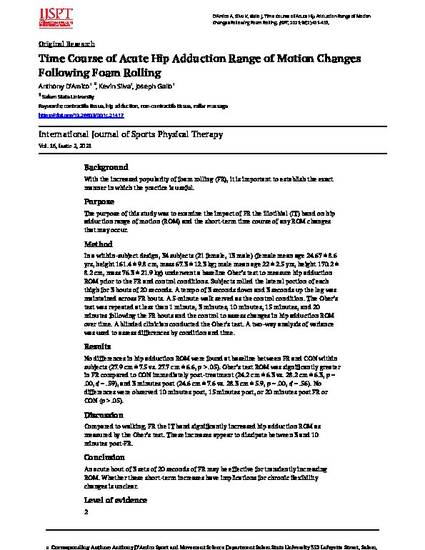
Article
Time Course of Acute Hip Adduction Range of Motion Changes Following Foam Rolling
International Journal of Sports Physical Therapy
(2021)
Abstract
Background
With the increased popularity of foam rolling (FR), it is important to establish the exact manner in which the practice is useful.
Purpose
The purpose of this study was to examine the impact of FR the iliotibial (IT) band on hip adduction range of motion (ROM) and the short-term time course of any ROM changes that may occur.
Method
In a within-subject design, 34 subjects (21 female, 13 male) (female mean age 24.67 ± 8.6 yrs, height 161.4 ± 9.8 cm, mass 67.3 ± 12.3 kg; male mean age 22 ± 2.5 yrs, height 170.2 ± 8.2 cm, mass 76.3 ± 21.9 kg) underwent a baseline Ober’s test to measure hip adduction ROM prior to the FR and control conditions. Subjects rolled the lateral portion of each thigh for 3 bouts of 20 seconds. A tempo of 3 seconds down and 3 seconds up the leg was maintained across FR bouts. A 5-minute walk served as the control condition. The Ober’s test was repeated at less than 1 minute, 3 minutes, 10 minutes, 15 minutes, and 20 minutes following the FR bouts and the control to assess changes in hip adduction ROM over time. A blinded clinician conducted the Ober’s test. A two-way analysis of variance was used to assess differences by condition and time.
Results
No differences in hip adduction ROM were found at baseline between FR and CON within subjects (27.9 cm ± 7.5 vs. 27.7 cm ± 6.6, p > .05). Ober’s test ROM was significantly greater in FR compared to CON immediately post-treatment (24.2 cm ± 6.3 vs. 28.2 cm ± 6.3, p = .00, d = .59), and 3 minutes post (24.6 cm ± 7.6 vs. 28.3 cm ± 5.9, p = .00, d = .56). No differences were observed 10 minutes post, 15 minutes post, or 20 minutes post FR or CON (p > .05).
Discussion
Compared to walking, FR the IT band significantly increased hip adduction ROM as measured by the Ober’s test. These increases appear to dissipate between 3 and 10 minutes post-FR.
Conclusion
An acute bout of 3 sets of 20 seconds of FR may be effective for transiently increasing ROM. Whether these short-term increases have implications for chronic flexibility changes is unclear.
Level of Evidence
2
Keywords
- contractile tissue,
- hip adduction,
- non-contractile tissue,
- roller massage
Disciplines
Publication Date
April, 2021
DOI
10.26603/001c.21417
Citation Information
Anthony Damico, Kevin Silva and Joseph Gallo. "Time Course of Acute Hip Adduction Range of Motion Changes Following Foam Rolling" International Journal of Sports Physical Therapy Vol. 16 Iss. 2 (2021) p. 431 - 437 Available at: http://works.bepress.com/anthony-damico/4/
Creative Commons license

This work is licensed under a Creative Commons CC_BY-NC-ND International License.
